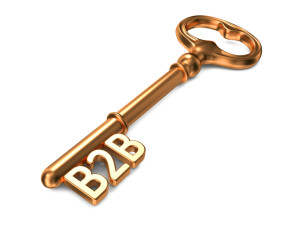by gabriel_sales | Feb 17, 2014
 Every marketing survey and report seems to be touting the same advice: create more, quality content.
Every marketing survey and report seems to be touting the same advice: create more, quality content.
For most businesses engaged in content marketing, coming up with a few blog ideas and an initial white paper is pretty easy. Consistently coming up with ideas two years later is a bit more difficult.
We’ve put together a list of seven ideas for generating quality B2B content on a consistent basis:
1. News sources
Creating content that references something happening in the news is now a fairly common practice. The news your content references must be relevant to your business or solution in some way. You can set up alerts on Google with specific keywords or key phrases, so you will be notified immediately when something pertaining your business occurs. This type of content does not have to be complex or very detailed; just restate the ‘news’ portion and add a few paragraphs of commentary giving your take on the issue.
2. Legal/regulatory compliance updates
For companies selling products and services that have legal or compliance related issues, giving your readers updates can be highly valuable. The Dodd Frank Bill and the Affordable Care Act are two recent examples of regulatory changes that are having a huge impact on their respective industries. By giving expert commentary and advice on how to handle these types of changes, you can highlight your status as an industry thought leader while giving readers something they will find truly valuable.
3. Features updates
Another good idea for ongoing content production is features or services updates. This is pretty common sense, but every time you update your product, service, delivery method, training process or anything else that adds value to the business, write a blog or make a video about it. Make sure that if you use the content in marketing campaigns, send it to your current customers (as well as your current prospects) for a potential upsell opportunity.
To continue reading the second half of this blog series, click here.
by gabriel_sales | Feb 13, 2014
 Over the past few years, we have created a lot of different types of videos for our clients. We are finding that one of the most valuable types of videos to use in the B2B sales process is a ‘headshot’ video of an executive.
Over the past few years, we have created a lot of different types of videos for our clients. We are finding that one of the most valuable types of videos to use in the B2B sales process is a ‘headshot’ video of an executive.
These are effective for several reasons. First, they allow prospects to start to get to know the people behind the company. B2B sales is (and has always been) about relationship building and headshot videos help to start this process in a digital format. Second, humans are hardwired to pay attention to faces; apparently, the Fusiform Facial area of the brain causes this. In the midst of thousands of marketing messages coming at your prospects each day, anything that can encourage them to pay more attention is good.
If you have never created a headshot video before, here are 5 basic tips to help you get started:
- Dress professionally. What this means may differ from company to company (i.e. an enterprise software company vs. a hip, new tech startup), but looking the part is always a good place to start. Make sure your clothes, hair, makeup, etc. are in line with your company’s image.
- Address sound quality. For people new to video production, sound can be a hard thing to get right. Start by making sure there is no background noise in the space you are recording. To create a tone of professionalism, make sure your executive has a relatively high-quality microphone.
- Check your lighting. If you do not have a professional video studio with lighting, your best bet is to shoot in a room with a lot of natural light. Whatever you do, stay away from harsh lighting and directional lighting for headshots.
- Add a text bar. For headshot videos, you want it to be immediately clear who is speaking. Always put the name and title of the featured executive in a text bar at the beginning and end of the video.
- Don’t shoot with your iPhone. This goes without saying, but you need to produce high quality videos if you want them to be effective as a sales tool. Your best bet is to shoot in HD. If this is not affordable, try to go for a 16:9 aspect ratio and a resolution of at least 640×360.
If you would like to see an example of an executive headshot video, you can watch this testimonial video from one of our clients. For more on the value of video in B2B sales, read 3 Reasons You Should Leverage B2B Video in 2014.
by gabriel_sales | Feb 12, 2014
 While 93% of B2B companies are now engaged in content marketing, it seems many are still struggling to see their content have a direct impact on sales. An interesting survey from McKinsey suggests the reason for this has to do with the branding or messaging behind the content. The data shows that what companies think makes a good brand and what customers want from a brand are two different things.
While 93% of B2B companies are now engaged in content marketing, it seems many are still struggling to see their content have a direct impact on sales. An interesting survey from McKinsey suggests the reason for this has to do with the branding or messaging behind the content. The data shows that what companies think makes a good brand and what customers want from a brand are two different things.
The survey asked B2B customers what they cared about most when looking to select a company or brand. The three top responses were:
- Cares about honest, open dialogue with its customers and society
- Acts responsibly across its supply chain
- Has a high level of specialist expertise
However, when B2B companies were asked what branding message they were conveying to customers, the top three responses were:
- Role-models corporate social responsibility in its work
- Promotes and practices sustainability in its products or services
- Has global reach
These findings suggest B2B companies are missing an opportunity to connect with customers by talking past them. It seems that B2B companies may be attempting way more than they need to in their branding and marketing content.
Based on these responses, B2B companies seem to think they need to save the world. They seem to think customers want superheroes who can travel the world at lighting speed and solve the world’s environmental problems in their free time.
While customers would probably like that, it is not what they care most about while shopping for a B2B solution. Looking at the top responses, B2B customers simply want to know that you are genuine, responsible and good at what you do.
So, when coming up with your brand story and determining how to best tell that story through digital content, don’t over complicate or attempt to be something more than you are. Just explain what you do and how you do it in an authentic and helpful way.
For more on telling a consistent brand story, read What Confuses Your Prospect Most About Your Sales Process. Feel free to contact us with any questions.
by gabriel_sales | Jan 30, 2014
 As we have written about previously, regardless of what the next hot marketing technology or trend is, content will be the fuel that gets us where we want to go. While many companies choose to produce their marketing content internally, there are several reasons that sales outsourcing might be a more cost-effective and efficient solution.
As we have written about previously, regardless of what the next hot marketing technology or trend is, content will be the fuel that gets us where we want to go. While many companies choose to produce their marketing content internally, there are several reasons that sales outsourcing might be a more cost-effective and efficient solution.
Here are 3 reasons to consider sales outsourcing content creation:
1. Marketers today are expected to act as publishers.
If you look at Salesforce’s blog, they are posting about 7 articles per day. Pardot, one of the leading marketing automation companies in the US, posts at least one every day. Oracle tweeted over 60 times on January 29th.
While your business may not need to be tweeting at the same rate as Oracle, you do need to publish relevant content, and you need to do it frequently. If your company is on the smaller side, this work can exhaust your resources, especially if you do not already have trained writers on staff. Similar to sales outsourcing, by leveraging an outsourced individual/team to write your blog articles and post them to social media, you can quickly and cost-effectively produce more content—improving both sales engagement and SEO.
2. Outsourced content producers understand how to tailor content to fit different stages of the buying cycle.
Each of your prospects is in a slightly different place in their buying cycle, and in order to move on to the next phase, each is going to need to see something slightly different. Prospects early in their buying cycle need to see very basic, educational content that speaks to their specific pains. Prospects closer to purchasing need to see detailed case studies, comparisons, demo videos, etc.
If you are not yet producing different types of content to match the various stages of your buying cycle, an outsourced content production team can help. By helping to map out each stage of your sales process and then coming up with different pieces of content for each, an outsourced team allows you to be confident that your content is actually working to bring prospects through your pipe and directly contributing to ROI.
3. It allows you to stay focused on serving your customers and looking for new revenue opportunities.
If you are at a tech startup or smaller managed services company, you likely do not have all the time in the world to sit around and come up with new ideas for content all the time. Even if you can come up with some ideas, seeing them through to execution can be difficult when you constantly have more pressing matters to attend to.
By leveraging outsourced content producers, you can stay focused on your company’s highest value activities—leaving content production to the experts.
For more on the value of outsourcing content production or other sales and marketing functions, read Scale Your Business for Sales with Sales Outsourcing. Feel free to contact us with any questions.
by gabriel_sales | Jan 30, 2014
 Answer: A lack of consistency.
Answer: A lack of consistency.
In today’s fast-paced and technology obsessed world, it has been estimated that people are exposed to 3,000-20,000 marketing messages per day (NYT).
While that estimate seems rather high, it highlights the sheer enormity of marketing content out there—all competing for our attention and clicks. In this chaotic and competitive environment, how do you create content that stands out enough to get your prospects to convert and/or buy?
You create an authentic brand story, and then tell that story consistently across multiple channels.
Telling a consistent brand story does not mean saying the exact same words over and over again in all of your marketing content. It means creating a consistent impression or experience for your prospect every time they interact with your company. Saying the same words multiple times may play a part in that, but there are also many other factors go into creating consistency for your prospects.
Let’s look at an example of an inconsistent brand story experience to illustrate the importance of consistency.
Let’s say George receives a marketing email from a managed service provider. The email has little in the way of color or graphics; the content of the email is educational, and the tone of the writing is serious and professional. George reads the email and decides to click through to the additional content being offered, as he is someone who highly values professionalism in the workplace.
However, when George clicks through to the MSP’s content, he finds a page with neon colored graphics, pushy advertisements and informal language. At first, George is so confused that he wonders if he even clicked on the right link. After confirming the MSP did indeed send him to this flashy, ad-covered web page, George is left even more puzzled.
He wonders which of the two experiences the company actually provides. One story being told insinuates the MSP is an industry thought-leader and approaches their work with a high level of professionalism and seriousness. The other story implies the MSP cares more about aesthetics and has more of a bold, ‘in-your-face’ type of approach to business.
Only one of these stories is appealing to George. But, because he cannot figure out which of the stories is true just by viewing the content, he is going to move on to a competitor who provides him with a less confusing—and more consistent—brand experience.
While George’s story is fictional, the problem of inconsistent marketing and sales content is real and may cause you to miss out on revenue opportunities. To make the brand story your are telling more consistent, pay attention to:
- your tone of voice
- your level of formality
- the colors, graphics and other visuals you use
- your communication frequency
- the connotations of the words you use
- your social media posting style
By providing a more consistent brand experience for your prospects throughout the length of your sales process, they will be much more willing to trust you and therefore eventually, make a purchase.
To learn more about improving your B2B sales process, read “3 Reasons Your B2B Sales is Failing”. Feel free to contact us with any questions.
 Every marketing survey and report seems to be touting the same advice: create more, quality content.
Every marketing survey and report seems to be touting the same advice: create more, quality content.




